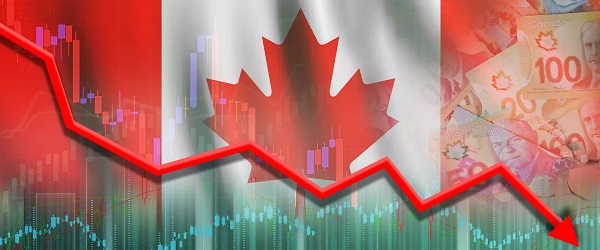Business
Next federal government has to unravel mess created by 10 years of Trudeau policies

From the Fraser Institute
It’s no exaggeration to describe the Trudeau years as almost a “lost decade” for Canadian prosperity.
The Justin Trudeau era is ending, after nine-and-a-half years as prime minister. His exit coincides with the onset of a trade crisis with the United States. Trudeau leaves behind a stagnant Canadian economy crippled by dwindling productivity, a long stretch of weak business investment, and waning global competitiveness. These are problems Trudeau chose to ignore throughout his tenure. His successors will not have that luxury.
It’s no exaggeration to describe the Trudeau years as almost a “lost decade” for Canadian prosperity. Measured on a per-person basis, national income today is barely higher than it was in 2015, after stripping out the effects of inflation. On this core metric of citizen wellbeing, Canada has one of the worst records among all advanced economies. We have fallen far behind the U.S., where average real income has grown by 15 per cent over the same period, and most of Europe and Japan, where growth has been in the range of 5-6 per cent.
Meanwhile, Ottawa’s debt has doubled on Trudeau’s watch, and both federal government spending and the size of the public service have ballooned, even as service levels have generally deteriorated. Housing in Canada has never been more expensive relative to average household incomes, and health care has never been harder to access. The statistics on crime point to a decline in public safety in the last decade.
Reviving prosperity will be the most critical task facing Trudeau’s successor. It won’t be easy, due in part to a brewing trade war with the U.S. and the retreat from open markets and free trade in much of the world. But a difficult external environment is no reason for Canada to avoid tackling the domestic impediments that discourage economic growth, business innovation and entrepreneurial wealth creation.
In a recent study, a group of economists and policy advisors outlined an agenda for renewed Canadian prosperity. Several of their main recommendations are briefly summarized below.
Return to the balanced budget policies embraced by the Chretien/Martin and Harper governments from 1995 to 2015. Absent a recession, the federal government should not run deficits. And the next government should eliminate ineffective spending programs and poor-performing federally-funded agencies.
Reform and reduce both personal and business income taxes. Canada’s overall income tax system is increasingly out of line with global best practise and has become a major barrier to attracting private-sector investment, top talent and world-class companies. A significant overhaul of the country’s tax policies is urgently needed.
Retool Ottawa’s existing suite of climate and energy policies to reduce the economic damage done by the long list of regulations, taxes, subsidies and other measures adopted Trudeau. Canada should establish realistic goals for lowering greenhouse gas emissions, not politically manufactured “targets” that are manifestly out of reach. Our climate policy should reflect the fact that Canada’s primary global comparative advantage is as a producer and exporter of energy and energy-intensive goods, agri-food products, minerals and other industrial raw materials which collectively supply more than half of the country’s exports.
Finally, take a knife to interprovincial barriers to trade, investment and labour mobility. These long-standing internal restrictions on commerce increase prices for consumers, inhibit the growth of Canadian-based companies, and result in tens of billions of dollars in lost economic output. The next federal government should lead a national effort to strengthen the Canadian “common market” by eliminating such barriers.
Business
Trump demands free passage for American ships through Panama, Suez

 MxM News
MxM News
Quick Hit:
President Donald Trump is pushing for U.S. ships to transit the Panama and Suez canals without paying tolls, arguing the waterways would not exist without America.
Key Details:
-
In a Saturday Truth Social post, Trump said, “American Ships, both Military and Commercial, should be allowed to travel, free of charge, through the Panama and Suez Canals! Those Canals would not exist without the United States of America.”
-
Trump directed Secretary of State Marco Rubio to “immediately take care of, and memorialize” the issue, signaling a potential new diplomatic initiative with Panama and Egypt.
-
The Panama Canal generated about $3.3 billion in toll revenue in fiscal 2023, while the Suez Canal posted a record $9.4 billion. U.S. vessels account for roughly 70% of Panama Canal traffic, according to government figures.
Diving Deeper:
President Donald Trump is pressing for American ships to receive free passage through two of the world’s most critical shipping lanes—the Panama and Suez canals—a move he argues would recognize the United States’ historic role in making both waterways possible. In a post shared Saturday on Truth Social, Trump wrote, “American Ships, both Military and Commercial, should be allowed to travel, free of charge, through the Panama and Suez Canals! Those Canals would not exist without the United States of America.”
— Rapid Response 47 (@RapidResponse47) April 26, 2025
Trump added that he has instructed Secretary of State Marco Rubio to “immediately take care of, and memorialize” the situation. His comments, first reported by FactSet, come as U.S. companies face rising shipping costs, with tolls for major vessels ranging from $200,000 to over $500,000 per Panama Canal crossing, based on canal authority schedules.
The Suez Canal, operated by Egypt, reportedly saw record revenues of $9.4 billion in 2023, largely driven by American and European shipping amid ongoing Red Sea instability. After a surge in attacks by Houthi militants on commercial ships earlier this year, Trump authorized a sustained military campaign targeting missile and drone sites in northern Yemen. The Pentagon said the strikes were part of an effort to “permanently restore freedom of navigation” for global shipping near the Suez Canal.
Trump has framed the military operations as part of a broader strategy to counter Iranian-backed destabilization efforts across the Middle East.
Meanwhile, in Central America, Trump’s administration is working to counter Chinese influence near the Panama Canal. On April 9th, Defense Secretary Pete Hegseth announced an expanded partnership with Panama to bolster canal security, including a memorandum of understanding allowing U.S. warships and support vessels to move “first and free” through the canal. “The Panama Canal is key terrain that must be secured by Panama, with America, and not China,” Hegseth emphasized during a press conference in Panama City.
American commercial shipping has long depended on the canal, which reduces the shipping route between the U.S. East Coast and Asia by nearly 8,000 miles. About 40% of all U.S. container traffic uses the Panama Canal annually, according to the U.S. Maritime Administration.
The United States originally constructed and controlled the Panama Canal following a monumental effort championed by President Theodore Roosevelt in the early 20th century. After backing Panama’s independence from Colombia in 1903, the U.S. secured the rights to build and operate the canal, which opened in 1914. Although U.S. control ended in 1999 under the Torrijos-Carter Treaties, the canal remains vital to U.S. trade.
2025 Federal Election
Columnist warns Carney Liberals will consider a home equity tax on primary residences

From LifeSiteNews
The Liberals paid a group called Generation Squeeze, led by activist Paul Kershaw, to study how the government could tap into Canadians’ home equity — including their primary residences.
Winnipeg Sun Columnist Kevin Klein is sounding the alarm there is substantial evidence the Carney Liberal Party is considering implementing a home equity tax on Canadians’ primary residences as a potential huge source of funds to bring down the massive national debt their spending created.
Klein wrote in his April 23 column and stated in his accompanying video presentation:
The Canada Mortgage and Housing Corporation (CMHC) — a federal Crown corporation — has investigated the possibility of a home equity tax on more than one occasion, using taxpayer dollars to fund that research. This was not backroom speculation. It was real, documented work.
The Liberals paid a group called Generation Squeeze, led by activist Paul Kershaw, to study how the government could tap into Canadians’ home equity — including their primary residences.
Kershaw, by the way, believes homeowners are “lottery winners” who didn’t earn their wealth but lucked into it. That’s the ideology being advanced to the highest levels of government.
It didn’t stop there. These proposals were presented directly to federal cabinet ministers. That’s on record, and most of those same ministers are now part of Mark Carney’s team as he positions himself as the Liberals’ next leader.
Watch below Klein’s 7-minute, impassionate warning to Canadians about this looming major new tax should the Liberals win Monday’s election.
Klein further adds:
The total home equity held by Canadians is over $4.7 trillion. It’s the largest pool of private wealth in the country. For millions of Canadians — especially baby boomers — it’s the only retirement fund they have. They don’t have big pensions. They have a paid-off house and a hope that it will carry them through their later years. Yet, that’s what Ottawa has quietly been circling.
The Canadian Taxpayer’s Federation has researched this issue and published a report on the alarming amount of new taxation a homeowner equity tax could cost Canadians who sell their homes that have increased in value over the years they have lived in it. It is a shocker!
A Google search on the question, “what is a home equity tax?” returns the response:
A home equity tax, simply put, it’s a proposed levy on the increased value of your home, specifically, on your principal residence. The idea is for Government to raise money by taxing wealth accumulation from rising property values.
The Canadian Taxpayers Federation has provided a Home Equity Tax Calculator Backgrounder to help Canadians understand what the impact of three different types of Home Equity Tax Calculators would have on home owners. The required tax payment resulting from all three is a shocker.
Keep in mind that World Economic Forum policies intend to eventually eliminate all private home ownership and have the state own and control not only all residences, but also eliminate car ownership, and control when and where you may live and travel.
Carney, Trudeau and several other members of the Liberal government in key positions are heavily connected to the WEF.
-

 2025 Federal Election2 days ago
2025 Federal Election2 days agoThe Federal Brief That Should Sink Carney
-

 2025 Federal Election2 days ago
2025 Federal Election2 days agoHow Canada’s Mainstream Media Lost the Public Trust
-

 2025 Federal Election2 days ago
2025 Federal Election2 days agoOttawa Confirms China interfering with 2025 federal election: Beijing Seeks to Block Joe Tay’s Election
-

 Media21 hours ago
Media21 hours agoCBC retracts false claims about residential schools after accusing Rebel News of ‘misinformation’
-

 John Stossel2 days ago
John Stossel2 days agoClimate Change Myths Part 2: Wildfires, Drought, Rising Sea Level, and Coral Reefs
-

 2025 Federal Election2 days ago
2025 Federal Election2 days agoReal Homes vs. Modular Shoeboxes: The Housing Battle Between Poilievre and Carney
-

 COVID-192 days ago
COVID-192 days agoNearly Half of “COVID-19 Deaths” Were Not Due to COVID-19 – Scientific Reports Journal
-

 Bjorn Lomborg20 hours ago
Bjorn Lomborg20 hours agoNet zero’s cost-benefit ratio is CRAZY high


